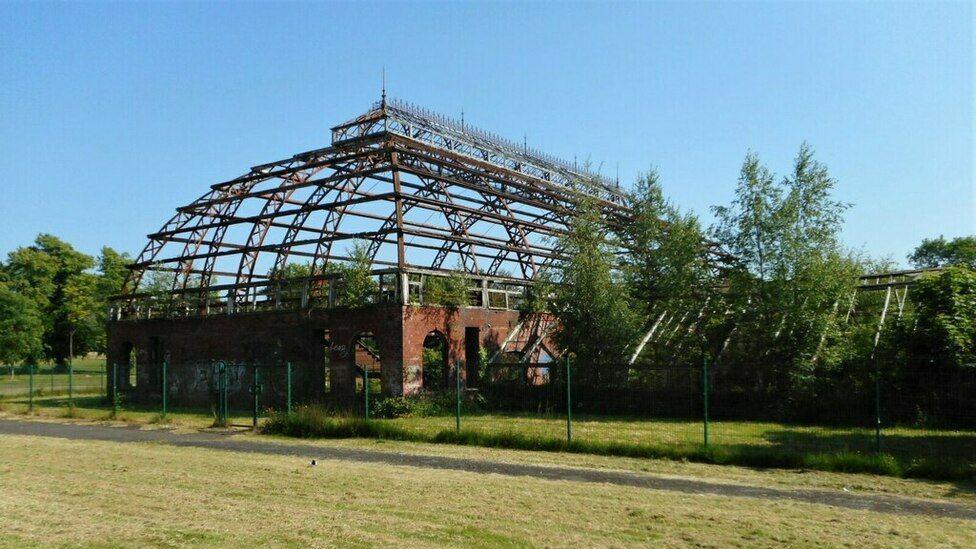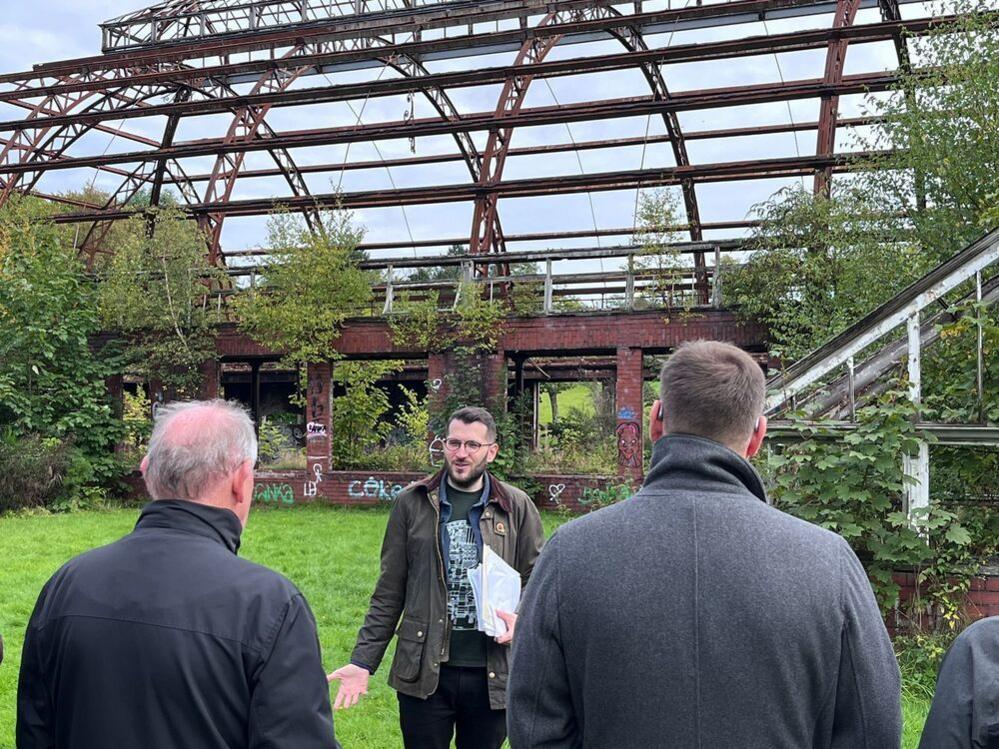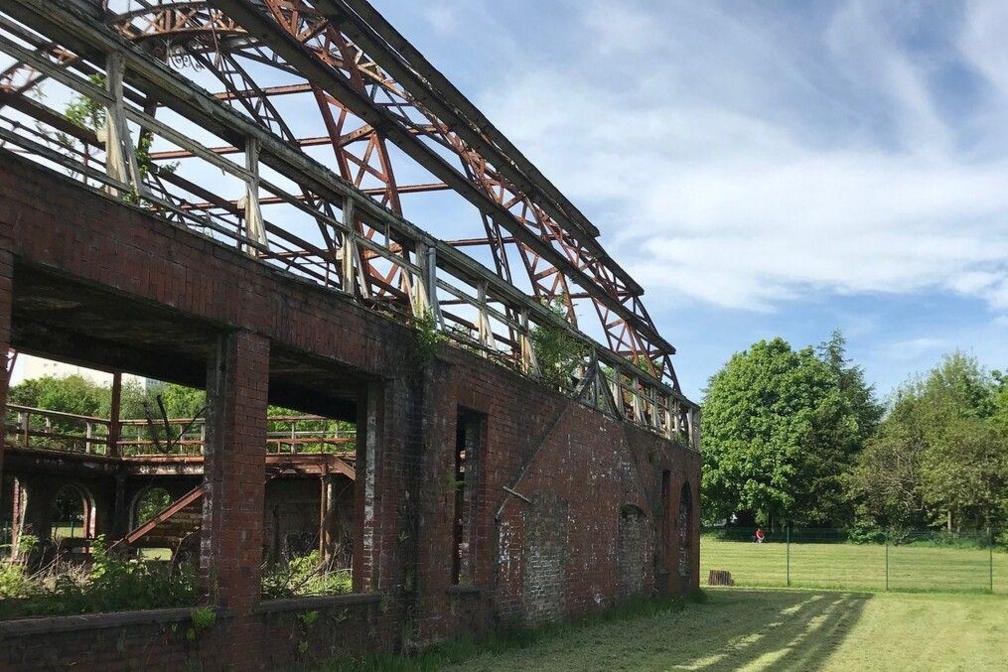What next for the glasshouse in ruins for 40 years?

Springburn Winter Gardens has fallen into disrepair since the 1980s
- Published
More than 40 years since its sudden closure, a community trust is hoping to revitalise Scotland's largest glasshouse as a "living ruin".
Springburn Winter Gardens opened in north Glasgow in 1900 but in 1983 a devastating storm forced it to close.
Now the glass panes are long gone, and nature appears to be reclaiming the graffitied brick walls and the ageing metal roof frame that remain.
However, a community trust hopes to breathe new life into the ruins, by repurposing it as an arts and culture centre.
Plans for the £8m project include a venue for performances and events, a nursery, event and office spaces, allotments, and a cafe/bar.

The glasshouse was popular before it fell into disrepair
Springburn Park was opened by the Glasgow Corporation in 1892.
As the site of the main manufacturer of locomotives for the British empire, Springburn was thriving in the first half of the 20th Century.
And the family of Sir Hugh Reid, who built the largest locomotive works in the city, invested a lot of money in the park.
They donated a bandstand for live music performances, while the family's investment kickstarted plans for the glasshouse.
The Winter Gardens was well-loved by generations of Springburn residents for its displays of exotic plants and for the concerts and exhibitions held there.
Brian Davey, 50, grew up in Springburn and became one of the founding members of Springburn Winter Gardens Trust 11 years ago.
“My father was a councillor in Springburn for 20-odd years and he was very much responsible for keeping the building upright," he said.
“It was open when I was wee, and the gardens were really popular.
"I remember they had live gigs with local bands and petting zoos with chicks and bunnies in Easter."

The glasshouse held events and performances
The fortunes of Springburn declined in the 1960s when the locomotive industry collapsed.
“Then Springburn had a road run through it in the 80s and the expressway destroyed the majority of the old tenement buildings," Mr Davey said.
The Springburn Expressway passes through what was once the historic centre of the area.
“There was a sense of apathy from people, that the council had forgotten about us and smashed up the place and left us with practically nothing," he added.
“All you ever saw were gap sites and buildings come down. I just remember seeing everyone’s wallpaper when the gable ends were brought down.”
Labour MSP Paul Sweeney, who chairs the Springburn Winter Gardens Trust, is leading efforts to secure phased funding to restore the site and turn it into a venue for north Glasgow.
"Springburn was once a really vibrant area and one of the key communities in the city," he said.

Paul Sweeney chairs the trust seeking to restore the glasshouse
"But it was totally destroyed by the 1970s and around 80% of Springburn's built environment was demolished within a 20-year period.
"The population declined by 60%. It's probably the most severely damaged community in Scotland."
Many people left the area due to the lack of any major employers to replace the railway companies, as well as the decaying state of housing.
In 1983, the glasshouse was severely damaged by a storm and the council had no money to carry out the urgent repairs.
The local authority had plans in motion to demolish the site within two years.
But just days before the demolition, the building was granted listed status by the Scottish Office. It was later placed on the Buildings at Risk Register.
In 2014, after years of neglect, it was classed as a ruin at critical risk.

The glasshouse boasted many exotic plant species
Mr Sweeney told BBC Scotland News that the shock demolition of Springburn Public Halls in 2012 prompted locals to take action to preserve their heritage.
The council blamed safety fears for the need to take action quickly.
"That was really the impetus for the Winter Gardens project," he said.
"Over Christmas, they knocked down the beautiful Springburn Public Halls which was shocking. We managed to go down and save some of the sculptures from that.
"But that prompted a big summit down in Springburn with the MP, MSP, community councillors, and we started planning how we could save the Winter Gardens."


The trust hopes to make a start on preservation works to make the building safe to use for events, before potentially taking over the site from the council.
It secured emergency funding from Glasgow City Heritage Trust in 2017 to prevent the roof from collapsing.
"But now we want to consider how we go from surviving to activating the building in some way," Mr Sweeney added.
He said the trust planned to secure the shell of the building and then hold events in it, such as markets and festivals, or open-air cinema nights.
However in November the project missed out on "essential" Levelling Up funding.
"It's just frustrating that the Winter Gardens in decline has become a symbol for the area," he said.
"So if we turn it around, Springburn could become a place folk go out of their way to go to."
Get in touch
What stories you would like BBC News to cover from Glasgow and the west of Scotland?